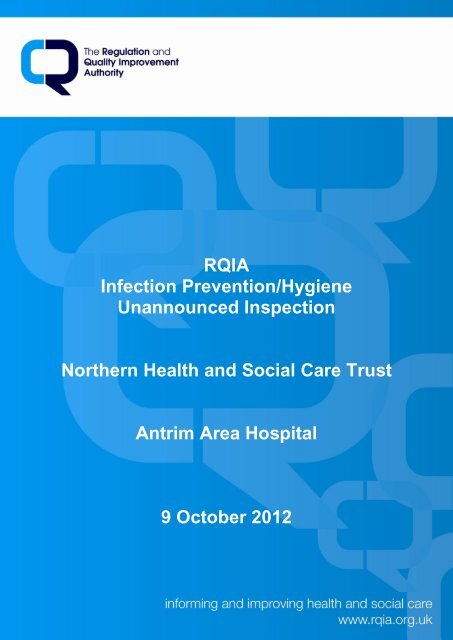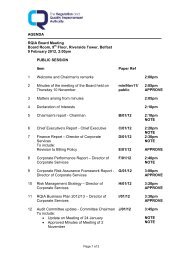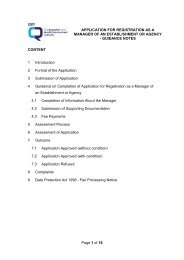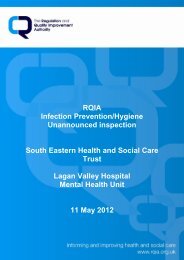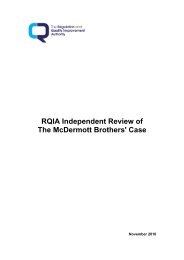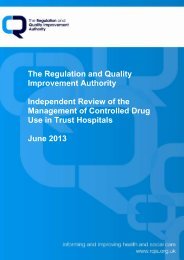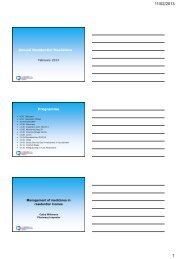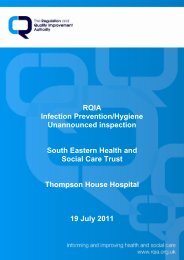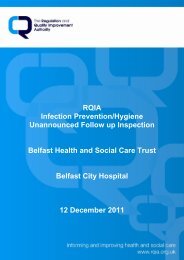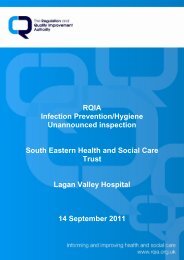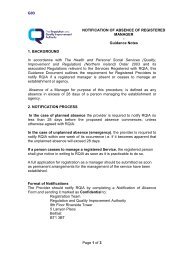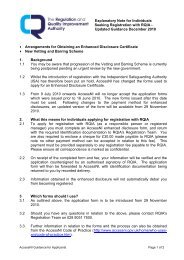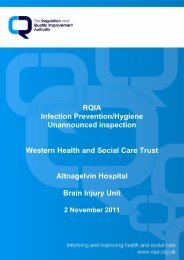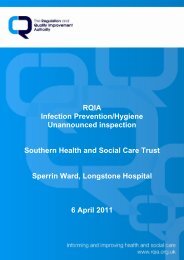Antrim Area Hospital, Antrim - 09 October 2012 - Regulation and ...
Antrim Area Hospital, Antrim - 09 October 2012 - Regulation and ...
Antrim Area Hospital, Antrim - 09 October 2012 - Regulation and ...
You also want an ePaper? Increase the reach of your titles
YUMPU automatically turns print PDFs into web optimized ePapers that Google loves.
RQIA<br />
Infection Prevention/Hygiene<br />
Unannounced Inspection<br />
Northern Health <strong>and</strong> Social Care Trust<br />
<strong>Antrim</strong> <strong>Area</strong> <strong>Hospital</strong><br />
9 <strong>October</strong> <strong>2012</strong>
Contents<br />
1.0 Inspection Summary 1<br />
2.0 Background Information to the Inspection Process 5<br />
3.0 Inspections 6<br />
4.0 Unannounced Inspections Process 7<br />
4.1 Onsite Inspection 7<br />
4.2 Feedback <strong>and</strong> Report of the findings 7<br />
5.0 Audit Tool 8<br />
6.0 Environment 10<br />
6.1 Cleaning 10<br />
6.2 Clutter 12<br />
6.3 Maintenance <strong>and</strong> Repair 13<br />
6.4 Fixture <strong>and</strong> Fittings 14<br />
6.5 Information 14<br />
6.6 Additional Issues 15<br />
7.0 Patient Linen 17<br />
7.1 Management of Linen 17<br />
8.0 Waste <strong>and</strong> Sharps 18<br />
8.1 Waste 18<br />
8.2 Sharps 18<br />
9.0 Patient Equipment 20<br />
10.0 Hygiene Factors 22<br />
11.0 Hygiene Practice 24<br />
12.0 Key Personnel <strong>and</strong> Information 27<br />
13.0 Summary of Recommendations 29<br />
14.0 Unannounced Inspection Flowchart 31<br />
15.0 RQIA Hygiene Team Escalation Policy Flowchart 32<br />
16.0 Action Plan 33
1.0 Inspection Summary<br />
An unannounced inspection was undertaken to the <strong>Antrim</strong> <strong>Area</strong><br />
<strong>Hospital</strong>, on the 9 <strong>October</strong> <strong>2012</strong>. The hospital was assessed against<br />
the Regional Healthcare Hygiene <strong>and</strong> Cleanliness St<strong>and</strong>ards <strong>and</strong> the<br />
following areas were inspected:<br />
Ward C1 - Gynae <strong>and</strong> Early Pregnancy Unit<br />
Ward C4 - Elective Surgery <strong>and</strong> ENT<br />
Ward C5 - Surgical<br />
Ward A3 – Renal(Dialysis), Oncology, Haematology,<br />
Rheumatology <strong>and</strong> general medicine<br />
Inspection Outcomes<br />
The results of the inspection show all wards achieved an overall<br />
compliance level; in particular the staff in Wards C1 <strong>and</strong> C4 are<br />
commended for achieving compliance with each st<strong>and</strong>ard.<br />
Observation of staff in all wards indicated compliance with many<br />
sections within the st<strong>and</strong>ards.<br />
The main concern identified on this inspection was the variety of<br />
specialty services provided in Ward A3, such as Renal Dialysis,<br />
Oncology, Haematology, Rheumatology <strong>and</strong> general medical patients.<br />
This created a large footfall of staff in the ward <strong>and</strong> has impacted on<br />
some scores achieved. Of particular concern was the size <strong>and</strong> layout<br />
of Bay 1 where care was delivered to the renal dialysis patients. The<br />
trust should review the suitability of this ward to care for so many<br />
augmented care patients.<br />
Inspectors observed that the environment in general was clean,<br />
however lack of storage within all wards impacted on the ability to<br />
achieve clutter free ward environments. Of note is Ward A3 where the<br />
extremely cluttered environment has impacted negatively on cleaning<br />
practices.<br />
Inspectors found that further improvement was required in Ward A3 in<br />
the h<strong>and</strong>ling, storage <strong>and</strong> segregation of waste <strong>and</strong> hygiene practices<br />
st<strong>and</strong>ards. In the hygiene practices st<strong>and</strong>ard, Ward A3 scored a<br />
minimal compliance in the section effective cleaning of the ward <strong>and</strong><br />
partial compliance in h<strong>and</strong> hygiene procedures, safe h<strong>and</strong>ling <strong>and</strong><br />
disposal of sharps <strong>and</strong> correct use of isolation sections.<br />
Although all wards scored overall compliance for the st<strong>and</strong>ard<br />
regarding hygiene factors, the section on materials <strong>and</strong> equipment for<br />
cleaning, indicates that more work is required to improve practice in<br />
Wards A3 <strong>and</strong> C5. Further work is also required in these wards<br />
concerning correct use of isolation.<br />
1
Ward C5 was minimally compliant for the availability, use, storage of<br />
sharps st<strong>and</strong>ard indicating that knowledge <strong>and</strong> practice need to<br />
improve to ensure safe <strong>and</strong> appropriate practice is in place.<br />
The inspection resulted in 20 recommendations for the NHSCT <strong>and</strong> the<br />
<strong>Antrim</strong> <strong>Area</strong> <strong>Hospital</strong>, a full list of recommendations is listed in Section<br />
13.<br />
A detailed list of preliminary findings is forwarded to Northern Health<br />
<strong>and</strong> Social Care Trust within 14 days of the inspection to enable early<br />
action on identified areas which have achieved non complaint scores.<br />
The draft report which includes the high level recommendations in a<br />
Quality Improvement Plan is forwarded within 28 days of the inspection<br />
for agreement <strong>and</strong> factual accuracy. The draft report is agreed <strong>and</strong> a<br />
completed action plan is returned to RQIA within 14 days from the date<br />
of issue. The detailed list of preliminary findings is available from RQIA<br />
on request.<br />
The final report <strong>and</strong> Quality Improvement Plan will be available on the<br />
RQIA website. Reports <strong>and</strong> action plans will be subject to performance<br />
management by the Health <strong>and</strong> Social Care Board <strong>and</strong> the Public<br />
Health Agency.<br />
Notable Practice<br />
The inspection identified the following areas of notable practice:<br />
Weekly walkabouts with the ward manager <strong>and</strong> domestic<br />
supervisor<br />
Deep clean of wards twice a year<br />
Whiteboard displaying audits <strong>and</strong> IPC staff link staff<br />
Good infection prevention <strong>and</strong> control practice displayed by<br />
third year nursing students in Ward C5<br />
All patients in Ward C1 are swabbed for MRSA on admission<br />
with results available in 24 hours<br />
The RQIA inspection team would like to thank the NHSCT <strong>and</strong> in<br />
particular all staff at the <strong>Antrim</strong> <strong>Area</strong> hospital for their assistance during<br />
the inspection.<br />
The following tables give an overview of compliance scores noted in<br />
areas inspected by RQIA:<br />
Table 1 summarises the overall compliance levels achieved.<br />
Tables 2-7 summarise the individual tables for sections two to seven of<br />
the audit tool as this assists the organisation to target areas that<br />
require more specific attention.<br />
2
Table 1<br />
<strong>Area</strong>s inspected C1 A3 C4 C5<br />
General environment 90 80 93 87<br />
Patient linen 97 100 100 100<br />
Waste 92 83 90 97<br />
Sharps 95 90 94 71<br />
Equipment 86 88 97 85<br />
Hygiene factors 95 94 99 91<br />
Hygiene practices 90 84 95 91<br />
Average Score 92 88 95 89<br />
Table 2<br />
General environment C1 A3 C4 C5<br />
92 N/A N/A<br />
Corridors, stairs lift 81 87 92 96<br />
Public toilets 90 N/A N/A N/A<br />
Ward/department -<br />
general (communal)<br />
92 91 97 85<br />
Patient bed area 90 74 90 90<br />
Bathroom/washroom 95 81 92 88<br />
Toilet N/A 91 100 90<br />
Clinical room/treatment<br />
room<br />
N/A 80 93 N/A<br />
Clean utility room 89 N/A 94 83<br />
Dirty utility room 94 84 92 91<br />
Domestic store 100 74 97 81<br />
Kitchen 92 88 94 88<br />
Equipment store N/A 75 N/A 84<br />
Isolation 92 68 90 86<br />
General information 75 69 83 85<br />
Average Score 90 80 93 87<br />
Table 3<br />
Patient linen C1 A3 C4 C5<br />
Storage of clean linen 100 100 100 100<br />
Storage of dirty linen 93 100 100 100<br />
Laundry facilities N/A N/A N/A N/A<br />
Average Score 97 100 100 100<br />
Compliant:<br />
85% or above<br />
Partial Compliance: 76% to 84%<br />
Minimal Compliance: 75% or below<br />
3
Table 4<br />
Waste <strong>and</strong> sharps C1 A3 C4 C5<br />
H<strong>and</strong>ling, segregation,<br />
storage, waste<br />
92 83 90 97<br />
Availability, use, storage<br />
of sharps<br />
95 90 94 71<br />
Table 5<br />
Patient equipment C1 A3 C4 C5<br />
Patient equipment 86 88 97 85<br />
Table 6<br />
Hygiene factors C1 A3 C4 C5<br />
Availability <strong>and</strong><br />
cleanliness of wash<br />
h<strong>and</strong> basin <strong>and</strong><br />
96 94 95 97<br />
consumables<br />
Availability of alcohol<br />
rub<br />
100 100 100 100<br />
Availability of PPE 92 100 100 86<br />
Materials <strong>and</strong><br />
equipment for cleaning<br />
91 83 98 81<br />
Average Score 95 94 98 91<br />
Table 7<br />
Hygiene practices C1 A3 C4 C5<br />
Effective h<strong>and</strong> hygiene<br />
procedures<br />
93 84 95 95<br />
Safe h<strong>and</strong>ling <strong>and</strong><br />
disposal of sharps<br />
92 79 100 92<br />
Effective use of PPE 100 100 100 89<br />
Correct use of isolation N/A 83 N/A 79<br />
Effective cleaning of<br />
ward<br />
83 65 95 95<br />
Staff uniform <strong>and</strong> work<br />
wear<br />
81 95 87 93<br />
Average Score 90 84 95 91<br />
Compliant:<br />
85% or above<br />
Partial Compliance: 76% to 84%<br />
Minimal Compliance: 75% or below<br />
4
2.0 Background Information to the Inspection Process<br />
RQIA’s infection prevention <strong>and</strong> hygiene team was established to<br />
undertake a rolling programme of unannounced inspections of acute<br />
hospitals. The Department of Health Social Service <strong>and</strong> Public Safety<br />
(DHSSPS) commitment to a programme of hygiene inspections was<br />
reaffirmed through the launch in 2010 of the revised <strong>and</strong> updated<br />
version of 'Changing the Culture' the strategic regional action plan for<br />
the prevention <strong>and</strong> control of healthcare-associated infections (HCAIs)<br />
in Northern Irel<strong>and</strong>.<br />
The aims of the inspection process are:<br />
to provide public assurance <strong>and</strong> to promote public trust <strong>and</strong><br />
confidence<br />
to contribute to the prevention <strong>and</strong> control of HCAI<br />
to contribute to improvement in hygiene, cleanliness <strong>and</strong> infection<br />
prevention <strong>and</strong> control across health <strong>and</strong> social care in Northern<br />
Irel<strong>and</strong><br />
In keeping with the aims of the RQIA, the team will adopt an open <strong>and</strong><br />
transparent method for inspection, using st<strong>and</strong>ardised processes <strong>and</strong><br />
documentation.<br />
5
3.0 Inspections<br />
The DHSSPS has devised draft Regional Healthcare Hygiene <strong>and</strong><br />
Cleanliness st<strong>and</strong>ards. RQIA has revised its inspection processes to<br />
support the publication of the st<strong>and</strong>ards which were compiled by a<br />
regional steering group in consultation with service providers.<br />
RQIA's infection prevention/hygiene team have planned a three year<br />
programme which includes announced <strong>and</strong> unannounced inspections<br />
in acute <strong>and</strong> non-acute hospitals in Northern Irel<strong>and</strong>. This will assess<br />
compliance with the DHSSPS Regional Healthcare Hygiene <strong>and</strong><br />
Cleanliness st<strong>and</strong>ards.<br />
The inspections will be undertaken in accordance with the four core<br />
activities outlined in the RQIA Corporate Strategy, these include:<br />
Improving care: we encourage <strong>and</strong> promote improvements in the<br />
safety <strong>and</strong> quality of services through the regulation <strong>and</strong> review of<br />
health <strong>and</strong> social care<br />
Informing the population: we publicly report on the safety,<br />
quality <strong>and</strong> availability of health <strong>and</strong> social care<br />
Safeguarding rights: we act to protect the rights of all people<br />
using health <strong>and</strong> social care services<br />
Influencing policy: we influence policy <strong>and</strong> st<strong>and</strong>ards in health<br />
<strong>and</strong> social care<br />
6
4.0 Unannounced Inspection Process<br />
Trusts receive no advanced notice of the onsite inspection. An email<br />
<strong>and</strong> telephone call will be made by the Chief Executive of RQIA or<br />
nominated person 30 minutes prior to the team arriving on site.<br />
The inspection flow chart is attached in Section 14.<br />
4.1 Onsite Inspection<br />
The inspection team was made up of four inspectors from RQIA’s<br />
infection prevention/hygiene team along with four peer reviewers.<br />
One inspector led the team <strong>and</strong> was responsible for guiding the team<br />
<strong>and</strong> ensuring they were in agreement about the findings reached.<br />
Membership of the inspection team is outlined in Section 12.<br />
The inspection of ward environments is carried out using the draft<br />
Regional Healthcare Hygiene <strong>and</strong> Cleanliness audit tool.<br />
The inspection process involves observation, discussion with staff, <strong>and</strong><br />
review of some ward documentation.<br />
4.2 Feedback <strong>and</strong> Report of the Findings<br />
The process concludes with a feedback of key findings to trust<br />
representatives including examples of notable practice identified during<br />
the inspection. The details of trust representatives attending the<br />
feedback session is outlined in Section 12.<br />
The findings, report <strong>and</strong> follow up action will be in accordance with the<br />
Infection Prevention/Hygiene Inspection Process (methodology, follow<br />
up <strong>and</strong> reporting).<br />
The infection prevention/hygiene team escalation process will be<br />
followed if inspectors/reviewers identify any serious concerns during<br />
the inspection (Section 15).<br />
A number of documents have been developed to support <strong>and</strong> explain<br />
the inspection process. This information is currently available on<br />
request <strong>and</strong> will be available in due course on the RQIA website.<br />
7
5.0 Audit Tool<br />
The audit tool used for the inspection is based on the draft Regional<br />
Healthcare Hygiene <strong>and</strong> Cleanliness st<strong>and</strong>ards. The st<strong>and</strong>ards<br />
incorporate the critical areas which were identified through a review of<br />
existing st<strong>and</strong>ards, guidance <strong>and</strong> audit tools (Appendix 2 of Regional<br />
Healthcare Hygiene <strong>and</strong> Cleanliness st<strong>and</strong>ards). The audit tool follows<br />
the format of the draft Regional Healthcare Hygiene <strong>and</strong> Cleanliness<br />
St<strong>and</strong>ards <strong>and</strong> comprises of the following sections.<br />
1. Organisational Systems <strong>and</strong> Governance: policies <strong>and</strong><br />
procedures in relation to key hygiene <strong>and</strong> cleanliness issues;<br />
communication of policies <strong>and</strong> procedures; roles <strong>and</strong><br />
responsibilities for hygiene <strong>and</strong> cleanliness issues; internal<br />
monitoring arrangements; arrangements to address issues<br />
identified during internal monitoring; communication of internal<br />
monitoring results to staff<br />
This st<strong>and</strong>ard is not audited when carrying out unannounced<br />
inspections however the findings of the organisational<br />
system <strong>and</strong> governance at annual announced inspection will<br />
be, where applicable, confirmed at ward level.<br />
2. General Environment: cleanliness <strong>and</strong> state of repair of public<br />
areas; cleanliness <strong>and</strong> state of repair of ward/department<br />
infrastructure; cleanliness <strong>and</strong> state of repair of patient bed area;<br />
cleanliness <strong>and</strong> state of repair of toilets, bathrooms <strong>and</strong><br />
washrooms; cleanliness <strong>and</strong> state of repair of ward/department<br />
facilities; availability <strong>and</strong> cleanliness of isolation facilities;<br />
provision of information for staff, patients <strong>and</strong> visitors<br />
3. Patient Linen: storage of clean linen; h<strong>and</strong>ling <strong>and</strong> storage of<br />
used linen; ward/department laundry facilities<br />
4. Waste <strong>and</strong> Sharps: waste h<strong>and</strong>ling; availability <strong>and</strong> storage of<br />
sharps containers<br />
5. Patient Equipment: cleanliness <strong>and</strong> state of repair of general<br />
patient equipment<br />
6. Hygiene Factors: h<strong>and</strong> wash facilities; alcohol h<strong>and</strong> rub;<br />
availability of personal protective equipment (PPE); availability of<br />
cleaning equipment <strong>and</strong> materials<br />
7. Hygiene Practices: h<strong>and</strong> hygiene procedures; h<strong>and</strong>ling <strong>and</strong><br />
disposal of sharps; use of PPE; use of isolation facilities <strong>and</strong><br />
implementation of infection control procedures; cleaning of<br />
ward/department; staff uniform <strong>and</strong> work wear<br />
8
Level of Compliance<br />
Percentage scores can be allocated a level of compliance using the<br />
compliance categories below. The categories are allocated as follows:<br />
Compliant<br />
85% or above<br />
Partial compliance 76 to 84%<br />
Minimal compliance 75% or below<br />
Each section within the audit tool will receive an individual <strong>and</strong> an<br />
overall score, to identify areas of partial or minimal compliance to<br />
ensure that the appropriate action is taken.<br />
9
6.0 Environment<br />
STANDARD 2.0<br />
GENERAL ENVIRONMENT<br />
Cleanliness <strong>and</strong> state of repair of public areas; cleanliness <strong>and</strong><br />
state of repair of ward/department infrastructure; cleanliness <strong>and</strong><br />
state of repair of patient bed area; cleanliness <strong>and</strong> state of repair<br />
of toilets, bathrooms <strong>and</strong> washrooms; cleanliness <strong>and</strong> state of<br />
repair of ward/department facilities; availability <strong>and</strong> cleanliness<br />
of isolation facilities; provision of information for staff, patients<br />
<strong>and</strong> visitors.<br />
General environment C1 A3 C4 C5<br />
92 N/A N/A<br />
Corridors, stairs lift 81 87 92 96<br />
Public toilets 90 N/A N/A N/A<br />
Ward/department -<br />
general (communal)<br />
92 91 97 85<br />
Patient bed area 90 74 90 90<br />
Bathroom/washroom 95 81 92 88<br />
Toilet N/A 91 100 90<br />
Clinical room/treatment<br />
room<br />
N/A 80 93 N/A<br />
Clean utility room 89 N/A 94 83<br />
Dirty utility room 94 84 92 91<br />
Domestic store 100 74 97 81<br />
Kitchen 92 88 94 88<br />
Equipment store N/A 75 N/A 84<br />
Isolation 92 68 90 86<br />
General information 75 69 83 85<br />
Average Score 90 80 93 87<br />
The above table outlines the findings in relation to the general<br />
environment of the facilities inspected. The findings indicate that there<br />
were some areas for improvement identified in all wards, notably Ward<br />
A3, where clutter <strong>and</strong> lack of storage impacted on the ability to clean<br />
<strong>and</strong> have contributed to the minimally compliant areas highlighted in<br />
red. The findings in respect of the general environment are detailed in<br />
the following sections.<br />
6.1 Cleaning<br />
At the time of the inspection there was evidence in most areas to<br />
indicate compliance with regional specifications for cleaning.<br />
Inspectors observed that while cleaning mechanisms were in place to<br />
prevent the build-up of dust, debris <strong>and</strong> bacteria <strong>and</strong> subsequently<br />
10
educe the potential risk for the transmission of infection, they were not<br />
always implemented or adhered to.<br />
In the main reception, public toilet, corridors <strong>and</strong> stairs, leading to the<br />
wards, some high <strong>and</strong> low level surfaces including sanitary equipment<br />
were dusty, the external windows required cleaning; there was debris<br />
in light fittings. However in general the cleaning of these areas was<br />
good.<br />
Ward A3 cares for patients with a variety of illnesses <strong>and</strong> inspectors<br />
noted the extremely busy footfall within the ward itself. The ward did<br />
not achieve compliance for the majority of areas within this st<strong>and</strong>ard<br />
<strong>and</strong> was overall partially compliant. The requirement for specialised<br />
medical equipment necessary for some of these patients <strong>and</strong> the lack<br />
of storage facilities pose additional difficulties <strong>and</strong> have impacted on<br />
the ability to effectively clean difficult to reach <strong>and</strong> cluttered areas of<br />
the ward.<br />
The challenge for domestic staff in cleaning Bay 1 was evident to the<br />
inspectors who had difficultly checking beds <strong>and</strong> the equipment behind<br />
beds due to this lack of space. Radiators could not be cleaned as<br />
clinical waste bags <strong>and</strong> personal belongings were stored on top<br />
(Picture 1), chairs <strong>and</strong> bedside tables also required cleaning, debris<br />
was noted behind beds <strong>and</strong> in some light fittings.<br />
Picture 1: Untidy ward, clutter affecting cleaning practices<br />
Throughout the wards cleaning in general was of a good st<strong>and</strong>ard,<br />
some dust was noted on high <strong>and</strong> low horizontal surfaces such as high<br />
density storage, floors, skirting <strong>and</strong> air vents, excess toilet rolls were<br />
noted in sanitary areas <strong>and</strong> there was debris in some light fittings.<br />
In some areas further work to improve cleaning st<strong>and</strong>ards is required.<br />
Shower chairs were stained in the shower rooms of Wards A3, C1 <strong>and</strong><br />
C4. In Ward C5 the underside of the raised toilet seat was stained <strong>and</strong><br />
in Ward A3 the toilet brush required cleaning. The inside of the<br />
macerator lid in the dirty utility room of Wards C4 <strong>and</strong> C5, the slop<br />
hopper <strong>and</strong> domestic sluice bowl in Ward C5 <strong>and</strong> the sluice, radiators<br />
11
<strong>and</strong> cupboards in Ward A3 domestic store required more thorough<br />
cleaning.<br />
In the treatment room of Ward A3 the inside of the two fridges was<br />
grubby, <strong>and</strong> there were gaps in the fridge temperature checks.<br />
There was no documentation to record failures in the cold chain <strong>and</strong><br />
the fridge containing medication was overfull <strong>and</strong> unlocked, a similar<br />
issue in Ward C4.<br />
Inspectors in Wards A3, C1 <strong>and</strong> C5 observed that adhesive tape was<br />
used to attach labels or posters to surfaces which in some instances<br />
had left a sticky residue, impeding the cleaning process.<br />
Lime scale was observed on taps. Particular care is required to ensure<br />
that lime scale is removed from taps <strong>and</strong> fittings as recent evidence<br />
has shown that lime scale may harbour biofilms <strong>and</strong> the build-up of<br />
lime scale can interfere with good cleaning <strong>and</strong> disinfection by masking<br />
<strong>and</strong> protecting pathogens.<br />
Cleaning issues such as dusty horizontal surfaces; skirting, windows<br />
frames <strong>and</strong> excess toilet rolls were identified in rooms designated for<br />
isolation purposes. Additionally in Ward A3 side room, where a patient<br />
had a known infection, the light switch, wall panel, mirror, blind,<br />
underside of the bedside table <strong>and</strong> bed frame all required a more<br />
detailed clean <strong>and</strong> the waste pipe below the wash h<strong>and</strong> basin had a<br />
significant build-up of residue.<br />
Ward kitchens achieved a compliant score however there were some<br />
issues in regard to more attention to detail when cleaning equipment,<br />
horizontal surfaces <strong>and</strong> flooring that need addressed. In Wards C5<br />
<strong>and</strong> A3 decanted products were not labelled, in Ward A3 gaps in the<br />
temperature recordings for the fridge were noted.<br />
6.2 Clutter<br />
The provision of clutter free wards <strong>and</strong> effective utilisation of space <strong>and</strong><br />
good stock management assists with effective cleaning.<br />
Of particular note was Bay 1 in Ward A3, a six bedded bay with little<br />
space between beds, either vertically or horizontally, creating a very<br />
cluttered appearance. Similarly in Ward A3, the nurses’ station was<br />
cluttered with equipment, boxes were stored under the reception desk,<br />
the shower room beside Bay 5 was cluttered with 3 raised toilet seats<br />
<strong>and</strong> two shower chairs which would have created difficultly for patients<br />
accessing the shower. Space was not sufficient to allow for effective<br />
storage of equipment in the domestic store <strong>and</strong> items were observed<br />
on the floor of the dirty utility room.<br />
In Ward C4, the ENT day procedure clinic is located in the treatment<br />
room <strong>and</strong> patients for all procedures are required to wait in the corridor<br />
12
leading to the ward. The patient lounge is utilized for minor day<br />
procedures; the room was small <strong>and</strong> cluttered with patients <strong>and</strong><br />
equipment.<br />
The clean utility room, dirty utility room <strong>and</strong> equipment stores in Ward<br />
C5 did not have sufficient space to allow for effective storage of<br />
supplies <strong>and</strong> equipment. Stock was noted on top of cupboards <strong>and</strong> on<br />
the floor (Picture 2), the emergency access was blocked with stored<br />
equipment. Inspectors in all wards noted the lack of available storage<br />
facilities however in Ward C1 inspectors were impressed with the<br />
overall clutter free environment.<br />
6.3 Maintenance <strong>and</strong> Repair<br />
Picture 2: Ward C5 cluttered store room<br />
Wards C1 <strong>and</strong> C4 had been refurbished in June <strong>2012</strong> <strong>and</strong> were<br />
generally in good repair (Picture 3). However in all wards inspected<br />
<strong>and</strong> corridors leading to the wards, inspectors noted wall, skirting, door<br />
<strong>and</strong> paintwork damage.<br />
Picture 3: Newly renovated shower room<br />
Inspectors in Ward C1 noted stained flooring in some renovated rooms.<br />
The ward manager advised that the recently laid flooring had been<br />
surveyed by the trust architect <strong>and</strong> estates who agreed that the flooring<br />
was defective. It was expected that the contractor would remove <strong>and</strong><br />
13
eplace the flooring. In Ward C4 joins had not been sealed in the floor<br />
coving of the kitchen <strong>and</strong> patient bed area.<br />
Some of the plastic slats on the ceiling light above the nurses’ station in<br />
Ward C5 were missing <strong>and</strong> although there had been an attempt to<br />
repair damage to the wall edging in the toilet, plaster was missing.<br />
6.4 Fixtures <strong>and</strong> Fittings<br />
The fixtures, fittings <strong>and</strong> equipment in all wards were generally fit for<br />
purpose however common issues were identified for action. In all<br />
wards, wooden bedside tables were showing signs of wear <strong>and</strong> tear,<br />
the wooden surfaces <strong>and</strong> edges were worn to the bare wood in places<br />
<strong>and</strong> some frames were chipped. Ward C1 had plastic bed rails which<br />
were in good repair however inspectors observed chipped paint finish<br />
on some bed rails in the other wards inspected.<br />
With the exception of Ward C4, armchairs were at times worn to the<br />
bare wood; in Ward A3 a chair in a room used for isolation purposes<br />
had a torn seat cover. In a side room of Ward C1 slats were missing<br />
from the vertical blinds, window blinds were frayed at the edges in<br />
Wards C5 <strong>and</strong> A3, the metal legs of raised toilet seats <strong>and</strong> shower<br />
chairs were rusty. Also in Ward A3 oxygen cylinders were stored in the<br />
equipment store where there was no safety sign on the door.<br />
There was no toilet roll dispenser in the female public toilet at the main<br />
reception; toilet rolls were stored on a ledge close to the toilet.<br />
Inspectors observed a variety of dispensers throughout the wards.<br />
At the feedback trust representatives advised that the trust was in the<br />
process of tendering for the supply of toilet roll dispensers throughout<br />
facilities.<br />
6.5 Information<br />
A concerted effort had been made by staff in Wards A3 <strong>and</strong> C4 where<br />
there was minimum use of non-laminated posters. Although cleaning<br />
schedules were available in all wards, in Wards C1 <strong>and</strong> A3 they lacked<br />
detail of equipment <strong>and</strong> staff roles <strong>and</strong> responsibilities.<br />
Only Ward A3 displayed the National Patient Safety Agency (NPSA)<br />
guidelines for nursing staff to reference, however it was not displayed<br />
for domestic staff. With the exception of Ward C5, posters on the<br />
segregation of linen <strong>and</strong> waste were not displayed for staff to<br />
reference; management of an inoculation injury poster was not<br />
displayed in Wards C4 <strong>and</strong> C5.<br />
The lack of information leaflets on infection prevention <strong>and</strong> control,<br />
Clostridium difficile <strong>and</strong> MRSA for patients, carers <strong>and</strong> staff to<br />
reference impacted negatively on the audit for Ward A3.<br />
14
6.6 Additional Issues<br />
Ward A3<br />
Ward C4<br />
Ward C5<br />
The ward has increased capacity from 24 patients to 31. This<br />
reconfiguration has impacted on patient bed space <strong>and</strong><br />
subsequently the amount of equipment <strong>and</strong> stores needed for the<br />
specialties nursed within the ward.<br />
A variety of specialty services is present in this ward such as<br />
Renal Dialysis, Oncology, Haematology, Rheumatology <strong>and</strong><br />
general medicine patients. This ward is considered by the trust<br />
as an augmented care area; it is advised that when the new draft<br />
regional audit tools are disseminated by the DHSSPS the ward<br />
should review its practices. Discussions had also taken place<br />
with the senior management team <strong>and</strong> estates <strong>and</strong> a business<br />
plan regarding the ward has subsequently been submitted to the<br />
Board.<br />
Inspectors observed that only one member of support services<br />
staff was on duty to clean this busy <strong>and</strong> complex ward.<br />
Ward C4 has been opened since July <strong>and</strong> inspectors have<br />
concerns regarding capacity <strong>and</strong> space utilisation which could<br />
have a detrimental effect on on the patient’s experience (privacy<br />
<strong>and</strong> dignity) delivery of service. The ward, at full capacity on the<br />
day of inspection, has 18 beds, 12 surgical <strong>and</strong> 6 medical <strong>and</strong> a<br />
small patients’ lounge which has been designated for day<br />
procedures, such as blood transfusions. Minor refurbishment is<br />
planned for this area to improve the lighting <strong>and</strong> to install six<br />
recliner chairs. In addition an ENT day procedure clinic is located<br />
in the treatment room <strong>and</strong> patients for these procedures are<br />
required to wait in the corridor leading to the ward.<br />
Staff advised that the ward is be re-configured with the intention<br />
of reducing clutter <strong>and</strong> increasing storage capacity. Trust<br />
representatives advised that discussions have taken place<br />
concerning increasing the deliveries to the ward to enhance<br />
utilization of space <strong>and</strong> stock management.<br />
15
Recommendations<br />
1. The trust should work to improve, monitor <strong>and</strong> ensure that<br />
environmental cleaning is carried out effectively, that patient<br />
equipment is fit for purpose <strong>and</strong> that the environment is in a<br />
good state of repair.<br />
2. The trust should work on the repair <strong>and</strong> maintenance of ward<br />
<strong>and</strong> public environments <strong>and</strong> to replace damaged fixtures<br />
<strong>and</strong> fittings.<br />
3. The trust <strong>and</strong> staff should work to improve storage <strong>and</strong><br />
maintain clutter free ward environments.<br />
4. The trust should ensure all relevant information is available<br />
for patients, visitors <strong>and</strong> staff to reference.<br />
5. The trust should ensure that all staff are aware of the<br />
importance of monitoring fridge temperatures.<br />
16
7.0 Patient Linen<br />
STANDARD 3.0<br />
PATIENT LINEN<br />
Storage of clean linen; h<strong>and</strong>ling <strong>and</strong> storage of used linen; ward/<br />
department laundry facilities.<br />
Patient linen C1 A3 C4 C5<br />
Storage of clean linen 100 100 100 100<br />
Storage of dirty linen 93 100 100 100<br />
Laundry facilities N/A N/A N/A N/A<br />
Average Score 97 100 100 100<br />
7.1 Management of Linen<br />
Staff in all wards are to be commended for their good practices in the<br />
h<strong>and</strong>ling <strong>and</strong> storage of clean <strong>and</strong> used linen. Had the frame of linen<br />
skips in Ward C4 not been damaged, all wards would have been fully<br />
compliant in this st<strong>and</strong>ard.<br />
17
8.0 Waste <strong>and</strong> Sharps<br />
STANDARD 4.0<br />
WASTE AND SHARPS<br />
Waste: Effectiveness of arrangements for h<strong>and</strong>ling, segregation,<br />
storage <strong>and</strong> disposal of waste on ward/department<br />
Sharps: Availability, use <strong>and</strong> storage of sharps containers on<br />
ward/department<br />
Waste <strong>and</strong> sharps C1 A3 C4 C5<br />
H<strong>and</strong>ling, segregation,<br />
storage, waste<br />
92 83 90 97<br />
Availability, use, storage<br />
of sharps<br />
95 90 94 71<br />
8.1 Waste<br />
The inspection evidenced that only Ward A3 did not achieve<br />
compliance for the h<strong>and</strong>ling, segregation <strong>and</strong> storage of waste<br />
st<strong>and</strong>ard. Some issues were identified in all wards that require<br />
attention.<br />
In all wards waste was not disposed of into the correct waste stream in<br />
line with trust policy. Examples are blister packs, cotton wool, gloves<br />
<strong>and</strong> pharmaceutical vials in sharps boxes, disposable forceps <strong>and</strong><br />
blood stained dressings into yellow lidded burn bins. With the<br />
exception of Ward C5 paper waste had been disposed into clinical<br />
waste bins.<br />
Household waste bins were not available at all clinical h<strong>and</strong> wash sinks<br />
in Wards C1 <strong>and</strong> C4 <strong>and</strong> in Wards C1 <strong>and</strong> A3, at least one bin required<br />
more attention to detail when cleaning. Other staff practices affecting<br />
the audit in Ward A3 were the overfilling of the black lidded burn bin<br />
<strong>and</strong> ward waste bins, the disposal of patients’ clothing into the<br />
confidential waste bin <strong>and</strong> the disposal area which required cleaning.<br />
8.2 Sharps<br />
It was disappointing to note the minimal compliance score of Ward C5<br />
on the safe h<strong>and</strong>ling, segregation, storage <strong>and</strong> disposal of sharps<br />
st<strong>and</strong>ard, the three other wards achieved a high compliant score.<br />
Sharps boxes in use conformed to BS7320 (1990)/UN9291 st<strong>and</strong>ards;<br />
however in Ward C5 a large sharps box was not signed or dated.<br />
This is unsafe practice as correct labelling ensures that if there is a<br />
spillage of sharps waste from the sharps box or an injury to a staff<br />
member as a result of incorrect assembly/disposal, the area the sharps<br />
box originated from can be immediately identified. Identifying the origin<br />
18
of the sharps box <strong>and</strong> its contents is imperative to assist in the<br />
immediate risk assessment process carried out following a sharps<br />
injury <strong>and</strong> also to ensure that staff who incorrectly assembled/disposed<br />
of the sharps box can receive education on the correct procedures to<br />
follow.<br />
With the exception of Ward C4, temporary closure mechanisms on<br />
sharps boxes were not all in place when the box was not in use.<br />
Additional issues which impacted negatively on the audit for Ward C5,<br />
were regarding the dusty sharps box on the resuscitation trolley, a<br />
grubby sharps tray <strong>and</strong> staff not emptying <strong>and</strong> cleaning the paper<br />
mache insets <strong>and</strong> the sharps tray of equipment, after use.<br />
In Ward A3, a sharps box on a procedure trolley was overfilled <strong>and</strong> a<br />
large unsecured 50litre bin was perched on the top of the Phlebotomy<br />
trolley.<br />
Except for Ward A3, paper mache dishes were inserted into sharps<br />
trays. There are two issues here; the additional cost to the trust <strong>and</strong><br />
implications for the aseptic non touch technique (ANTT) practices as<br />
paper mache dishes cannot be effectively cleaned. At the feedback, a<br />
trust representative advised that the trust is considering the use of<br />
cleanable IV trolleys for ANTT procedures. This would also negate the<br />
need for sharps trays.<br />
Recommendations<br />
6. The trust should monitor the implementation of its policies<br />
<strong>and</strong> procedures in respect of the management of waste <strong>and</strong><br />
sharps to ensure that safe <strong>and</strong> appropriate practice is in<br />
place.<br />
7. The trust should ensure that waste bins <strong>and</strong> equipment used<br />
in the management of waste are available <strong>and</strong> kept clean.<br />
8. The trust <strong>and</strong> individual staff have a collective responsibility<br />
to ensure that staff knowledge is kept up to date regarding<br />
the safe <strong>and</strong> the correct h<strong>and</strong>ling <strong>and</strong> disposal of waste <strong>and</strong><br />
sharps is adhered to.<br />
19
9.0 Patient Equipment<br />
STANDARD 5.0<br />
PATIENT EQUIPMENT<br />
Cleanliness <strong>and</strong> state of repair of general patient equipment.<br />
Patient equipment<br />
C1 A3 C4 C5<br />
Patient equipment 86 88 97 85<br />
All wards were compliant for this st<strong>and</strong>ard, patient equipment was<br />
generally of a good st<strong>and</strong>ard <strong>and</strong> most equipment was visibly clean.<br />
Full compliance would have been achieved in Ward C4 had the low<br />
frame work of the resuscitation trolley been dust free. With the<br />
exception of Ward C4, trigger tape used to denote equipment, including<br />
commodes, had been cleaned <strong>and</strong> ready to use, was inconsistently<br />
used.<br />
Some equipment was worn or damaged such as IV st<strong>and</strong>s in Wards<br />
C1 <strong>and</strong> C5, the notes trolley <strong>and</strong> underside of the commode lids in<br />
Ward C5 <strong>and</strong> the frame of the hoist, wheel chair footplate <strong>and</strong> ice<br />
machine grill in Ward C1. Commodes in Ward A3 did not have a lid as<br />
they had been damaged; the inspectors were informed that new<br />
commodes were on order.<br />
In Ward C5 more attention to detail is required when cleaning fans, the<br />
legs <strong>and</strong> wheels of the procedure trolleys <strong>and</strong> the top surface of the<br />
resuscitation trolley. In Wards C5 <strong>and</strong> C1 single use jugs were being<br />
re-used, in Ward C1 adhesive tape was used to fix labels to the notes<br />
<strong>and</strong> linen trolleys <strong>and</strong> nursing staff did not know the symbol for single<br />
use equipment.<br />
Additional Issues<br />
Ward C1<br />
In a drawer of the resuscitation trolley, inspectors observed a<br />
10ml syringe stored out of packaging with the plunger withdrawn<br />
to the 10ml line (Picture 4). The ward manager advised this was<br />
for the insertion of air into a cuffed endotracheal tube.<br />
This practice allows for potential contamination <strong>and</strong> lack of<br />
traceability issues. The ward manager removed the exposed<br />
syringe immediately.<br />
20
Picture 4: Exposed syringe with 10ml inflated air<br />
Ward A3<br />
Ward C5<br />
The phlebotomy trolley was cluttered with notes, <strong>and</strong> a very large<br />
sharps bin therefore making cleaning difficult, the drawers of the<br />
trolley were damaged. Inspectors were informed that a new<br />
trolley was on order. In the interim the placement of notes <strong>and</strong><br />
sharps should be reviewed as these issues create difficulty with<br />
ensuring the optimal infection prevention <strong>and</strong> control practices are<br />
complied with.<br />
Inspectors observed an open <strong>and</strong> possibly used patient chest<br />
drain stored in the dirty utility room, this was reported to the ward<br />
manager for action.<br />
Recommendations<br />
9. The trust <strong>and</strong> individual staff have a collective responsibility<br />
to ensure that equipment is clean, stored correctly <strong>and</strong> in a<br />
good state of repair.<br />
10. The trust <strong>and</strong> individual staff have a collective responsibility<br />
to ensure that staff knowledge is kept up to date regarding<br />
equipment cleaning.<br />
21
10.0 Hygiene Factors<br />
STANDARD 6.0<br />
HYGIENE FACTORS<br />
H<strong>and</strong> wash facilities; alcohol h<strong>and</strong> rub; availability of PPE;<br />
availability of cleaning equipment <strong>and</strong> materials<br />
Hygiene factors C1 A3 C4 C5<br />
Availability <strong>and</strong><br />
cleanliness of wash<br />
h<strong>and</strong> basin <strong>and</strong><br />
96 94 95 97<br />
consumables<br />
Availability of alcohol<br />
rub<br />
100 100 100 100<br />
Availability of PPE 92 100 100 86<br />
Materials <strong>and</strong><br />
equipment for cleaning<br />
91 83 98 81<br />
Average Score 95 94 98 91<br />
All wards achieved compliance in this st<strong>and</strong>ard <strong>and</strong> for the section<br />
availability of alcohol rub. Wards A3 <strong>and</strong> C4 also achieved full<br />
compliance in the availability of PPE.<br />
With the exception of Ward C1, the number of sinks in the bays was<br />
not in line with local <strong>and</strong> national guidance. In the clean utility room of<br />
Wards C1 <strong>and</strong> C4, the taps at the clinical h<strong>and</strong> washing sink were not<br />
elbow or sensor operated, in Ward C1 they were not mixer taps <strong>and</strong><br />
the hot water ran at a high temperature.<br />
Some sinks <strong>and</strong> taps in Ward A3 required more detail cleaning. Issues<br />
affecting compliance in Wards C1, C4 <strong>and</strong> C5 were in regard to either<br />
empty dispensers or damaged dispensers, <strong>and</strong> stock including face<br />
<strong>and</strong> eye protection not always available. Only staff in Ward C1 stored<br />
chemicals in accordance with COSHH regulations.<br />
In Ward C1, RGNs did not know the dilution rate for the disinfectant in<br />
use, decanted disinfectant bottles were not dated <strong>and</strong> lid of containers<br />
of cleaning wipes were not closed therefore rendering the wipe<br />
ineffective, a similar issue in Ward C5.<br />
Wards C5 <strong>and</strong> A3 were partially compliant for the section concerning<br />
materials <strong>and</strong> equipment for cleaning, issues identified were in relation<br />
to staff practice such as equipment needing a more detailed clean, not<br />
stored correctly <strong>and</strong> in poor repair. In Ward A3, dirty mops were stored<br />
on the domestic cleaning trolley <strong>and</strong> mop h<strong>and</strong>les were not in line with<br />
NPSA colour coding guidance.<br />
22
Recommendations<br />
11. The trust should ensure that h<strong>and</strong> washing sinks <strong>and</strong><br />
consumables are available, clean, working <strong>and</strong> in a good<br />
state of repair.<br />
12. The trust should ensure that all cleaning products are stored<br />
in a locked cupboard, in line with COSHH regulations.<br />
13. Further attention to detail is required to ensure that<br />
equipment used for the general cleaning purposes of a ward<br />
is clean, used <strong>and</strong> stored appropriately <strong>and</strong> is fit for purpose.<br />
23
11.0 Hygiene Practices<br />
STANDARD 7.0<br />
HYGIENE PRACTICES<br />
H<strong>and</strong> hygiene procedures; h<strong>and</strong>ling <strong>and</strong> disposal of sharps; use<br />
of PPE; use of isolation facilities <strong>and</strong> implementation of infection<br />
control procedures; cleaning of ward/department; staff uniform<br />
<strong>and</strong> work wear.<br />
Hygiene practices C1 A3 C4 C5<br />
Effective h<strong>and</strong> hygiene<br />
procedures<br />
93 84 95 95<br />
Safe h<strong>and</strong>ling <strong>and</strong><br />
disposal of sharps<br />
92 79 100 92<br />
Effective use of PPE 100 100 100 89<br />
Correct use of isolation N/A 83 N/A 79<br />
Effective cleaning of<br />
ward<br />
83 65 95 95<br />
Staff uniform <strong>and</strong> work<br />
wear<br />
81 95 87 93<br />
Average Score 90 84 95 91<br />
Only Ward A3 did not achieve overall compliance in this st<strong>and</strong>ard,<br />
Ward C4 was fully compliant in two sections <strong>and</strong> issues were identified<br />
in all wards.<br />
In Wards C1 <strong>and</strong> C4 inspectors observed a doctor perform h<strong>and</strong><br />
decontamination incorrectly while using alcohol rub. Inspectors<br />
observed a number of staff in Ward A3 not using the seven step<br />
technique for h<strong>and</strong> washing <strong>and</strong> when using alcohol rub. Some staff in<br />
Ward C5 were observed not washing h<strong>and</strong>s before donning gloves.<br />
Only Ward C4 was fully compliant with the safe h<strong>and</strong>ling <strong>and</strong> disposal<br />
of sharps section. In Wards A3 <strong>and</strong> C1 re-sheathing of needles was<br />
noted in a sharps box <strong>and</strong> in Ward A3, sharps were not always<br />
disposed of at the point of care, an issue also identified in Ward C5.<br />
There were no patients with an infection in Wards C1 <strong>and</strong> C4 therefore<br />
the section, correct use of isolation, was not applicable. Issues<br />
identified in Wards C5 <strong>and</strong> A3 were in relation to documentation <strong>and</strong><br />
practice. In Ward A3, the nursing notes of a patient with Clostridium<br />
difficile were reviewed. The infection prevention <strong>and</strong> control<br />
assessment had not been updated from admission, the care pathway<br />
was kept in the medical notes therefore it was difficult to determine<br />
infection status from the nursing notes <strong>and</strong> inspectors noted areas of<br />
the room had not been cleaned properly although the room had been<br />
signed off as being cleaned.<br />
24
Similar issues were identified in Ward C5 where the red alert section<br />
on the nursing documentation did not identify that the patient had<br />
MRSA <strong>and</strong> there was no care plan present to enable staff to assess the<br />
patients care on a daily basis. Staff had also not completed the section<br />
on the nursing documentation that indicated the patient/family had<br />
received an information leaflet on MRSA.<br />
A detailed trust manual for domestic services is available (Picture 5).<br />
However in the effective cleaning of the ward section, Ward A3 was<br />
minimally compliant, Ward C1 was partially compliant <strong>and</strong> issues<br />
identified were regarding knowledge <strong>and</strong> practice. With the exception<br />
of Ward C5, COSHH data sheets on the disinfectant in use were not<br />
available for nursing staff <strong>and</strong> COSHH data sheets were not available<br />
for domestic staff in Ward A3. Nursing staff in Wards C1 <strong>and</strong> C5 were<br />
unsure of the NPSA colour coding system, in Wards C1 <strong>and</strong> A3, some<br />
nursing staff were unsure of the procedure to follow for blood <strong>and</strong> body<br />
spillages. Nursing staff in Ward A3 were also not fully aware of the<br />
dilution rate for the disinfectant in use for blood <strong>and</strong> body fluid<br />
spillages.<br />
Picture 5: Domestic Services store Manual<br />
In general dress code was of a high st<strong>and</strong>ard. However members of<br />
staff across all disciplines, but more notably in Wards C1 <strong>and</strong> C4 were<br />
not compliant with the trust dress code policy such as long hair not tied<br />
off the collar, wearing stoned rings <strong>and</strong> earrings, wrist watches <strong>and</strong> not<br />
complying with bare below the elbow.<br />
Additional Issues<br />
Ward C5<br />
Inspectors observed three sealed clexane injection packets an<br />
observation monitor trolley.<br />
In Room 25 a tablet had been left in a medicine cup in front of the<br />
sleeping patient rather than administered.<br />
25
Recommendations<br />
14. The trust <strong>and</strong> individual staff have a collective responsibility<br />
to ensure that h<strong>and</strong> hygiene is carried out in line with WHO<br />
guidance <strong>and</strong> that all PPE is used appropriately.<br />
15. The trust <strong>and</strong> individual staff have a collective responsibility<br />
to ensure that staff knowledge is kept up to date with regard<br />
to isolation, cleaning <strong>and</strong> decontamination of equipment.<br />
16. The trust <strong>and</strong> individual staff should ensure that all care plan<br />
<strong>and</strong> care pathway documentation is fully completed <strong>and</strong><br />
regularly reviewed.<br />
17. The trust <strong>and</strong> individual staff have a collective responsibility<br />
to ensure that staff knowledge is kept up to date regarding<br />
the use of disinfectants.<br />
18. The trust <strong>and</strong> individual staff have a collective responsibility<br />
to ensure COSHH data sheets are readily available for all staff<br />
to reference.<br />
19. The trust should ensure that all members of staff are familiar<br />
with <strong>and</strong> adhere to the regional dress code policy.<br />
20. The trust <strong>and</strong> individual staff have a collectible responsibility<br />
to ensure medicines are administered in accordance with the<br />
trust policy <strong>and</strong> the medicines management st<strong>and</strong>ard (20<strong>09</strong>).<br />
26
12.0 Key Personnel <strong>and</strong> Information<br />
Members of the RQIA inspection team<br />
Mrs E Colgan<br />
Mrs L Gawley<br />
Mrs S O’Connor<br />
Mrs M Keating<br />
- Senior Officer Infection Prevention/Hygiene Team<br />
- Inspector Infection Prevention/Hygiene Team<br />
- Inspector Infection Prevention/Hygiene Team<br />
- Inspector Infection Prevention/Hygiene Team<br />
Peer Reviewers<br />
Melanie Johnston<br />
Christine Goan<br />
Gillian Smyth<br />
Yvonne Black<br />
Domestic Manager SHSCT<br />
Senior Reviewer RQIA<br />
Patient Experience Manager<br />
Assistant Support Services Manager WHSCT<br />
Observors<br />
Damien O’Neill<br />
Gemma Mulholl<strong>and</strong><br />
Assistant Services Manager BHSCT<br />
Administration Supervisor CSCG, RQIA<br />
Trust representatives attending the feedback session<br />
The key findings of the inspection were outlined to the following trust<br />
representatives:<br />
Valerie Jackson Director Acute Services<br />
Suzanne Pullins Head of Governance <strong>and</strong> Patient Safety<br />
T. Martin Assistant Director Surgery/ATICS<br />
Linda Linford<br />
Assistant Director NHSCT<br />
Maire Bermingham Assistant Director Corporate Support<br />
Services<br />
Linda Patton<br />
General Manager Medical Specialities<br />
Avril Redmond<br />
Professional Lead for Nursing<br />
Peter Bartley<br />
Service Lead<br />
Mary Neeson<br />
Lead Nurse Surgery<br />
Naomi Baldwin<br />
Lead Nurse Infection Prevention <strong>and</strong><br />
Control<br />
Rosaleen Burns Ward Manager C1<br />
Anne-Marie Costello Ward Manager A3<br />
Bernie Irvine<br />
Ward Manager C5<br />
Ann Hamilton<br />
General Manager Domestic Services<br />
Trustwide<br />
Theresa O’Neill<br />
Ward Sister C4<br />
Nuala Mc Cormick Planning Supervisor, Estates Department<br />
A. Anderson B<strong>and</strong> 6 Ward A3<br />
Alan Steward<br />
Domestic Services Manager <strong>Antrim</strong> <strong>Area</strong><br />
<strong>Hospital</strong><br />
27
Supporting documentation<br />
A number of documents have been developed to support the inspection<br />
process, these are:<br />
Infection Prevention/Hygiene Inspection Process (methodology,<br />
follow up <strong>and</strong> reporting)<br />
Infection Prevention/Hygiene Team Inspection Protocol (this<br />
document contains details on how inspections are carried out <strong>and</strong><br />
the composition of the teams)<br />
Infection Prevention/Hygiene Team Escalation Policy<br />
RQIA Policy <strong>and</strong> Procedure for Use <strong>and</strong> Storage of Digital Images<br />
This information is currently available on request <strong>and</strong> will be available<br />
in due course on the RQIA website.<br />
28
13.0 Summary of Recommendations<br />
1. The trust should work to improve, monitor <strong>and</strong> ensure that<br />
environmental cleaning is carried out effectively, that patient<br />
equipment is fit for purpose <strong>and</strong> that the environment is in a<br />
good state of repair.<br />
2. The trust should work on the repair <strong>and</strong> maintenance of ward<br />
<strong>and</strong> public environments <strong>and</strong> to replace damaged fixtures<br />
<strong>and</strong> fittings.<br />
3. The trust <strong>and</strong> staff should work to improve storage <strong>and</strong><br />
maintain clutter free ward environments.<br />
4. The trust should ensure all relevant information is available<br />
for patients, visitors <strong>and</strong> staff to reference.<br />
5. The trust should ensure that all staff are aware of the<br />
importance of monitoring fridge temperatures.<br />
6. The trust should monitor the implementation of its policies<br />
<strong>and</strong> procedures in respect of the management of waste <strong>and</strong><br />
sharps to ensure that safe <strong>and</strong> appropriate practice is in<br />
place.<br />
7. The trust should ensure that waste bins <strong>and</strong> equipment used<br />
in the management of waste are available <strong>and</strong> kept clean.<br />
8. The trust <strong>and</strong> individual staff have a collective responsibility<br />
to ensure that staff knowledge is kept up to date regarding<br />
the safe <strong>and</strong> the correct h<strong>and</strong>ling <strong>and</strong> disposal of waste <strong>and</strong><br />
sharps is adhered to.<br />
9. The trust <strong>and</strong> individual staff have a collective responsibility<br />
to ensure that equipment is clean, stored correctly <strong>and</strong> in a<br />
good state of repair.<br />
10. The trust <strong>and</strong> individual staff have a collective responsibility<br />
to ensure that staff knowledge is kept up to date regarding<br />
equipment cleaning.<br />
11. The trust should ensure that h<strong>and</strong> washing sinks <strong>and</strong><br />
consumables are available, clean, working <strong>and</strong> in a good<br />
state of repair.<br />
12. The trust should ensure that all cleaning products are stored<br />
in a locked cupboard, in line with COSHH regulations.<br />
29
13. Further attention to detail is required to ensure that<br />
equipment used for the general cleaning purposes of a ward<br />
is clean, used <strong>and</strong> stored appropriately <strong>and</strong> is fit for purpose.<br />
14. The trust <strong>and</strong> individual staff have a collective responsibility<br />
to ensure that h<strong>and</strong> hygiene is carried out in line with WHO<br />
guidance <strong>and</strong> that all PPE is used appropriately.<br />
15. The trust <strong>and</strong> individual staff have a collective responsibility<br />
to ensure that staff knowledge is kept up to date with regard<br />
to isolation, cleaning <strong>and</strong> decontamination of equipment.<br />
16. The trust <strong>and</strong> individual staff should ensure that all care plan<br />
<strong>and</strong> care pathway documentation is fully completed <strong>and</strong><br />
regularly reviewed.<br />
17. The trust <strong>and</strong> individual staff have a collective responsibility<br />
to ensure that staff knowledge is kept up to date regarding<br />
the use of disinfectants.<br />
18. The trust <strong>and</strong> individual staff have a collective responsibility<br />
to ensure COSHH data sheets are readily available for all staff<br />
to reference.<br />
19. The trust should ensure that all members of staff are familiar<br />
with <strong>and</strong> adhere to the regional dress code policy.<br />
20. The trust <strong>and</strong> individual staff have a collectible responsibility<br />
to ensure medicines are administered in accordance with the<br />
trust policy <strong>and</strong> the medicines management st<strong>and</strong>ard (20<strong>09</strong>).<br />
30
Reporting & Re-Audit<br />
Episode of Inspection<br />
Plan Programme<br />
14.0 Unannounced Inspection Flowchart<br />
Environmental Scan:<br />
Stakeholders & External<br />
Information<br />
Plan<br />
Programme<br />
Consider:<br />
<strong>Area</strong>s of Non-Compliance<br />
Infection Rates<br />
Trust Information<br />
Prioritise Themes & <strong>Area</strong>s for Core Inspections<br />
Prior to Inspection Year<br />
Balance Programme<br />
January/February<br />
Schedule Inspections<br />
Prior to Inspection<br />
Identify & Prepare Inspection Team<br />
Day of Inspection<br />
Inform Trust<br />
Day of Inspection<br />
Carry out Inspection<br />
A<br />
Is there immediate risk<br />
requiring formal escalation?<br />
NO<br />
YES<br />
Invoke<br />
RQIA<br />
IPHTeam<br />
Escalation<br />
Process<br />
Day of Inspection<br />
Feedback Session with Trust<br />
14 days after<br />
Inspection<br />
28 days after<br />
Inspection<br />
Preliminary Findings<br />
disseminated to Trust<br />
Draft Report<br />
disseminated to Trust<br />
NO<br />
Does assessment of<br />
the findings require<br />
escalation?<br />
YES<br />
Invoke<br />
RQIA<br />
IPHTeam<br />
Escalation<br />
Process<br />
A<br />
14 days later<br />
Signed Action Plan<br />
received from Trust<br />
Within 0-3 months<br />
Is a Follow-Up required?<br />
Based on Risk Assessment/key<br />
indicators or Unsatisfactory Quality<br />
Improvement Plan (QIP)?<br />
YES<br />
Invoke<br />
Follow-Up<br />
Protocol<br />
Process enables<br />
only 1 Follow-Up<br />
NO<br />
Open Report published to Website<br />
YES<br />
Is Follow-Up<br />
satisfactory?<br />
NO<br />
DHSSPS/HSC<br />
Board/PHA<br />
PHA<br />
31
15.0 Escalation Process<br />
RQIA Hygiene Team: Escalation Process<br />
B<br />
RQIA IPH<br />
Team<br />
Escalation<br />
Process<br />
Concern / Allegation / Disclosure<br />
Inform Team Leader / Head of Programme<br />
MINOR/MODERATE<br />
Has the risk been<br />
assessed as Minor,<br />
Moderate or Major?<br />
MAJOR<br />
Inform key contact <strong>and</strong> keep a record<br />
Inform appropriate RQIA Director <strong>and</strong> Chief Executive<br />
Record in final report<br />
Inform Trust / Establishment / Agency<br />
<strong>and</strong> request action plan<br />
Notify Chairperson <strong>and</strong><br />
Board Members<br />
Inform other establishments as appropriate:<br />
E.g.: DHSSPS, RRT, HSC Board, PHA,<br />
HSENI<br />
Seek assurance on implementation of actions<br />
Take necessary action:<br />
E.g.: Follow-Up Inspection<br />
32
16.0 Action Plan<br />
<strong>Antrim</strong> <strong>Area</strong> <strong>Hospital</strong>, Action Plan, Unannounced Inspection, <strong>09</strong> <strong>October</strong> <strong>2012</strong><br />
Ref<br />
number<br />
Recommendations<br />
1. The trust should work to improve, monitor <strong>and</strong> ensure<br />
that environmental cleaning is carried out effectively,<br />
that patient equipment is fit for purpose <strong>and</strong> that the<br />
environment is in a good state of repair.<br />
Designated<br />
department<br />
Domestic/<br />
Estates<br />
Action required<br />
Domestic Management <strong>and</strong> staff have job<br />
descriptions which clarify roles <strong>and</strong><br />
responsibilities. St<strong>and</strong>ards of cleaning<br />
are monitored on a daily, monthly <strong>and</strong><br />
annual basis.<br />
Date for<br />
completion/<br />
timescale<br />
Actioned <strong>and</strong><br />
ongoing<br />
Leadership Walkabouts in place with<br />
Action Plans<br />
Audits are multi disciplinary ie; involve<br />
domestic services, estates, nursing <strong>and</strong><br />
infection prevention control staff <strong>and</strong><br />
managers.<br />
2. The trust should work on the repair <strong>and</strong> maintenance<br />
of ward <strong>and</strong> public environments <strong>and</strong> to replace<br />
damaged fixtures <strong>and</strong> fittings.<br />
Estates<br />
High cleaning is carried out by Estates<br />
services on rolling basis<br />
Damaged fixtures <strong>and</strong> fittings should be<br />
reported to the Estate Services Action<br />
Desk for repair.<br />
A rolling maintenance programme is in<br />
place.<br />
33
Ref<br />
number<br />
Recommendations<br />
3. The trust <strong>and</strong> staff should work to improve storage <strong>and</strong><br />
maintain clutter free ward environments.<br />
Designated<br />
department<br />
Domestic/<br />
Nursing<br />
Action required<br />
Domestic staff <strong>and</strong> nursing work together<br />
to reduce clutter in wards. Dump the<br />
Junk Days are carried out in trust<br />
hospitals. Info on how to dispose of<br />
unused items on Staff Net. Info re Dump<br />
the Junk on Staff payslips.<br />
Date for<br />
completion/<br />
timescale<br />
February 2013<br />
December<br />
<strong>2012</strong><br />
4. The trust should ensure all relevant information is<br />
available for patients, visitors <strong>and</strong> staff to reference.<br />
5. The trust should ensure that all staff are aware of the<br />
importance of monitoring fridge temperatures.<br />
Corporate<br />
Communicati<br />
ons/Heads of<br />
Departments/<br />
Lead Nurses<br />
Catering/<br />
Nursing/<br />
Domestic<br />
Services<br />
Consideration of appropriate storage is<br />
given as part of planning <strong>and</strong> design<br />
process as opportunities arise eg: new<br />
builds or refurbishments<br />
Trust is continuously reviewing leaflet<br />
content <strong>and</strong> availability through the<br />
analysis of patient <strong>and</strong> client experience<br />
questionnaires<br />
Availability of leaflets is also monitored at<br />
ward level during audits <strong>and</strong> walkabouts<br />
Directors will issue a reminder to staff<br />
regarding this important issue.<br />
Ongoing<br />
Continual<br />
Actioned <strong>and</strong><br />
ongoing<br />
34
Ref<br />
number<br />
Recommendations<br />
6. The trust should monitor the implementation of its<br />
policies <strong>and</strong> procedures in respect of the management<br />
of waste <strong>and</strong> sharps to ensure that safe <strong>and</strong><br />
appropriate practice is in place.<br />
Designated<br />
department<br />
Domestic/<br />
Nursing/<br />
Estates<br />
Services<br />
Action required<br />
All staff will be reminded at team<br />
meetings of policy on waste disposal.<br />
Ward Manager <strong>and</strong> Deputies will monitor<br />
waste management <strong>and</strong> sharps disposal<br />
taking corrective action as required<br />
Date for<br />
completion/<br />
timescale<br />
Estates waste manager provides training<br />
on regular basis.<br />
7. The trust should ensure that waste bins <strong>and</strong><br />
equipment used in the management of waste are<br />
available <strong>and</strong> kept clean.<br />
8. The trust <strong>and</strong> individual staff have a collective<br />
responsibility to ensure that staff knowledge is kept up<br />
to date regarding the safe <strong>and</strong> the correct h<strong>and</strong>ling<br />
<strong>and</strong> disposal of waste <strong>and</strong> sharps is adhered to.<br />
Domestic/<br />
Nursing<br />
Domestic/<br />
Infection<br />
Prevention<br />
Control/<br />
Estates<br />
waste officer<br />
Domestic Staff receive Training on waste<br />
as part of Induction <strong>and</strong> refresher training<br />
is organised as necessary.<br />
Domestic Supervisors <strong>and</strong> Ward<br />
Managers to identify at Daily/Monthly<br />
audits any unclean bins or bin needing<br />
replaced. Cleaning carried out<br />
immediately <strong>and</strong> bin replaced<br />
Waste <strong>and</strong> sharps management is<br />
monitored during ward/service based<br />
environmental cleanliness audits. Any<br />
examples of poor practice are reported<br />
<strong>and</strong> corrective action taken.<br />
Staff are aware that non compliance to<br />
policies regarding this area could result in<br />
disciplinary action. Memo issued to all<br />
Wards/Departments in Acute Directorate.<br />
Actioned <strong>and</strong><br />
Ongoing<br />
Actioned <strong>and</strong><br />
ongoing<br />
Actioned on a<br />
Daily basis<br />
35
Ref<br />
number<br />
Recommendations<br />
9. The trust <strong>and</strong> individual staff have a collective<br />
responsibility to ensure that equipment is clean, stored<br />
correctly <strong>and</strong> in a good state of repair.<br />
10. The trust <strong>and</strong> individual staff have a collective<br />
responsibility to ensure that staff knowledge is kept up<br />
to date regarding equipment cleaning.<br />
11. The trust should ensure that h<strong>and</strong> washing sinks <strong>and</strong><br />
consumables are available, clean, working <strong>and</strong> in a<br />
good state of repair.<br />
Designated<br />
department<br />
Domestic/<br />
Nursing<br />
Domestic/<br />
Nursing<br />
Domestic<br />
Services/<br />
Estates<br />
Services<br />
Action required<br />
Domestic <strong>and</strong> Nursing staff are aware of<br />
their respective responsibilities in relation<br />
to equipment cleanliness, usage <strong>and</strong><br />
state of repair. Equipments found to be<br />
below st<strong>and</strong>ard are isolated <strong>and</strong> either<br />
cleaned again, sent for repair or declared<br />
obsolete if damaged beyond repair.<br />
Domestic <strong>and</strong> Nursing staff are aware of<br />
which items of equipment they are<br />
responsible for cleaning at through<br />
schedules held at ward level. St<strong>and</strong>ard of<br />
cleaning is monitored through general<br />
daily observations <strong>and</strong> also as part of<br />
internal IPCEH audits. Where concerns<br />
are identified staff are retained in<br />
procedures.<br />
Domestic services staff have been trained<br />
in the requirements for cleaning <strong>and</strong> stock<br />
of h<strong>and</strong> basins.<br />
Cleanliness monitored on a daily basis by<br />
Domestic Supervisors.<br />
Date for<br />
completion/<br />
timescale<br />
Actioned <strong>and</strong><br />
ongoing<br />
Actioned <strong>and</strong><br />
Ongoing<br />
Ongoing<br />
Actioned<br />
12. The trust should ensure that all cleaning products are<br />
stored in a locked cupboard, in line with COSHH<br />
regulations.<br />
Domestic<br />
Services<br />
Estates services are carry out a<br />
replacement programme of any sinks<br />
found to be unfit for purpose<br />
Domestic supervisors will check on a<br />
daily basis as part of the daily<br />
observational checklist that all cleaning<br />
products are stored in line with COSHH<br />
regulations.<br />
Actioned<br />
36
Ref<br />
number<br />
Recommendations<br />
13. Further attention to detail is required to ensure that<br />
equipment used for the general cleaning purposes of a<br />
ward is clean, used <strong>and</strong> stored appropriately <strong>and</strong> is fit<br />
for purpose.<br />
14. The trust <strong>and</strong> individual staff have a collective<br />
responsibility to ensure that h<strong>and</strong> hygiene is carried<br />
out in line with WHO guidance <strong>and</strong> that all PPE is<br />
used appropriately.<br />
15. The trust <strong>and</strong> individual staff have a collective<br />
responsibility to ensure that staff knowledge is kept up<br />
to date with regard to isolation, cleaning <strong>and</strong><br />
decontamination of equipment.<br />
16. The trust <strong>and</strong> individual staff should ensure that all<br />
care plan <strong>and</strong> care pathway documentation is fully<br />
completed <strong>and</strong> regularly reviewed.<br />
Designated<br />
department<br />
Domestic/<br />
Nursing<br />
Domestic/<br />
Nursing/<br />
Other<br />
disciplines<br />
Nursing/<br />
Other<br />
disciplines<br />
Director<br />
Nursing<br />
Action required<br />
Training is given to all relevant staff in the<br />
usage <strong>and</strong> storage of cleaning equipment<br />
<strong>and</strong> products as part of their induction.<br />
Additional training is provided if<br />
equipment or products change<br />
H<strong>and</strong> hygiene monitored at ward level.<br />
Performance contained within Trust<br />
Board reports. Staff found to be non<br />
compliant are retrained <strong>and</strong> frequency of<br />
auditing is increased<br />
Relevant Directors to issue a reminder to<br />
staff regarding this important issue<br />
Relevant Directors to issue a reminder to<br />
staff regarding this important issue.<br />
Major project currently underway to<br />
introduce new Nursing Assessment <strong>and</strong><br />
Plan of Care documentation to all wards<br />
in acute hospitals.<br />
Date for<br />
completion/<br />
timescale<br />
Actioned<br />
Actioned <strong>and</strong><br />
Ongoing<br />
Actioned<br />
Actioned<br />
A Quality Improvement workstream,<br />
including monthly audits, monitors<br />
individual ward compliance with record<br />
keeping indicators. Electronic audit<br />
results are available at ward level for<br />
immediate improvement activity.<br />
37
Ref<br />
number<br />
Recommendations<br />
17. The trust <strong>and</strong> individual staff have a collective<br />
responsibility to ensure that staff knowledge is kept up<br />
to date regarding the use of disinfectants.<br />
Designated<br />
department<br />
Domestic/<br />
Nursing<br />
Action required<br />
Training is given to all relevant staff in the<br />
usage <strong>and</strong> storage of cleaning products<br />
as part of their induction.<br />
Date for<br />
completion/<br />
timescale<br />
Actioned <strong>and</strong><br />
Ongoing<br />
18. The trust <strong>and</strong> individual staff have a collective<br />
responsibility to ensure COSHH data sheets are<br />
readily available for all staff to reference.<br />
19. The trust should ensure that all members of staff are<br />
familiar with <strong>and</strong> adhere to the regional dress code<br />
policy.<br />
Director<br />
Nursing/<br />
Domestic<br />
Services<br />
All disciplines<br />
Additional training is provided if products<br />
change<br />
Relevant Directors to issue a reminder to<br />
staff regarding this important issue.<br />
All staff to be reminded of regional dress<br />
code policy <strong>and</strong> monitoring of adherence<br />
factored into audit process <strong>and</strong> general<br />
service management.<br />
Actioned<br />
Actioned<br />
Any revisions to current policy are issued<br />
on a cascade basis via directors for<br />
discussion with staff at team/ward/<br />
departmental meetings.<br />
38
Ref<br />
number<br />
Recommendations<br />
20. The trust <strong>and</strong> individual staff have a collectible<br />
responsibility to ensure medicines are administered in<br />
accordance with the trust policy <strong>and</strong> the medicines<br />
management st<strong>and</strong>ard (20<strong>09</strong>).<br />
Designated<br />
department<br />
Medical<br />
Director/<br />
Director<br />
Acute<br />
Services<br />
Action required<br />
Memo issued to all Wards/Departments in<br />
Acute Directorate.<br />
Audits also carried out on regular basis.<br />
Incidents <strong>and</strong> near misses monitored <strong>and</strong><br />
revised at Directorate levels.<br />
Date for<br />
completion/<br />
timescale<br />
Actioned <strong>and</strong><br />
completed<br />
Nursing <strong>and</strong> Midwifery Medicines<br />
Administration Policy is the benchmark<br />
against which all medicines are<br />
administered within the NHSCT.<br />
Pharmacy audits are conducted to review<br />
compliance with elements of same.<br />
Nursing Medication Reflection Tool<br />
completed by staff member when<br />
medicine incident occurs to encourage<br />
reflection on, <strong>and</strong> learning from, any<br />
incidents.<br />
39


